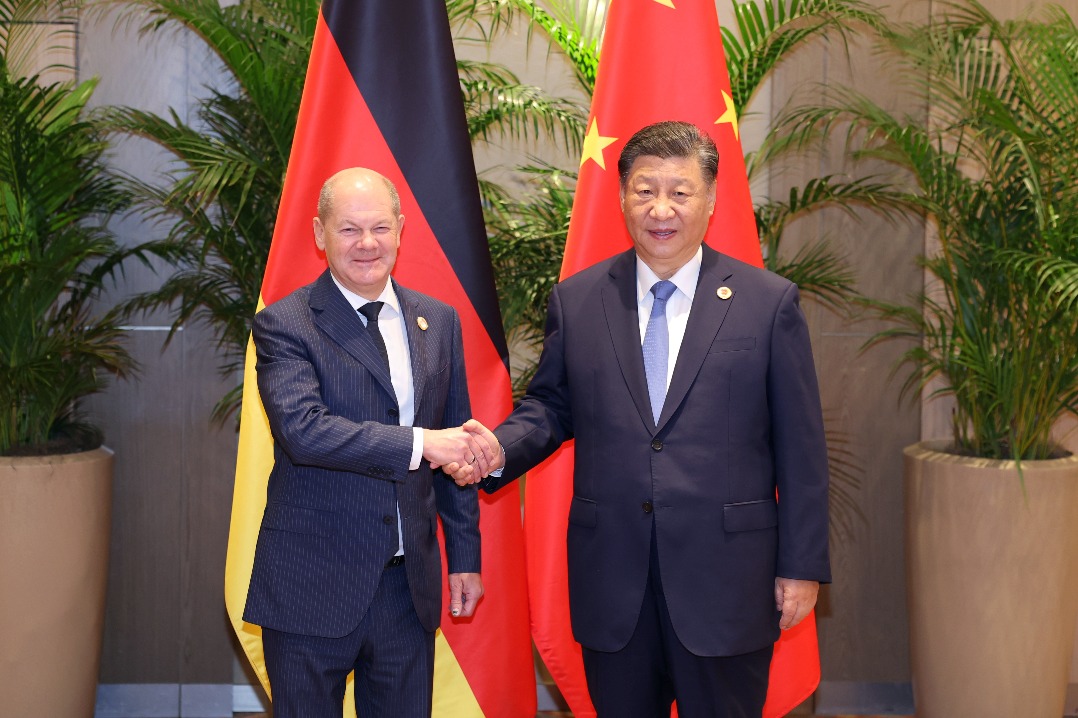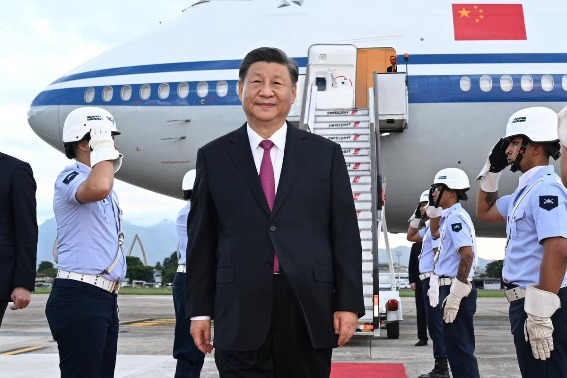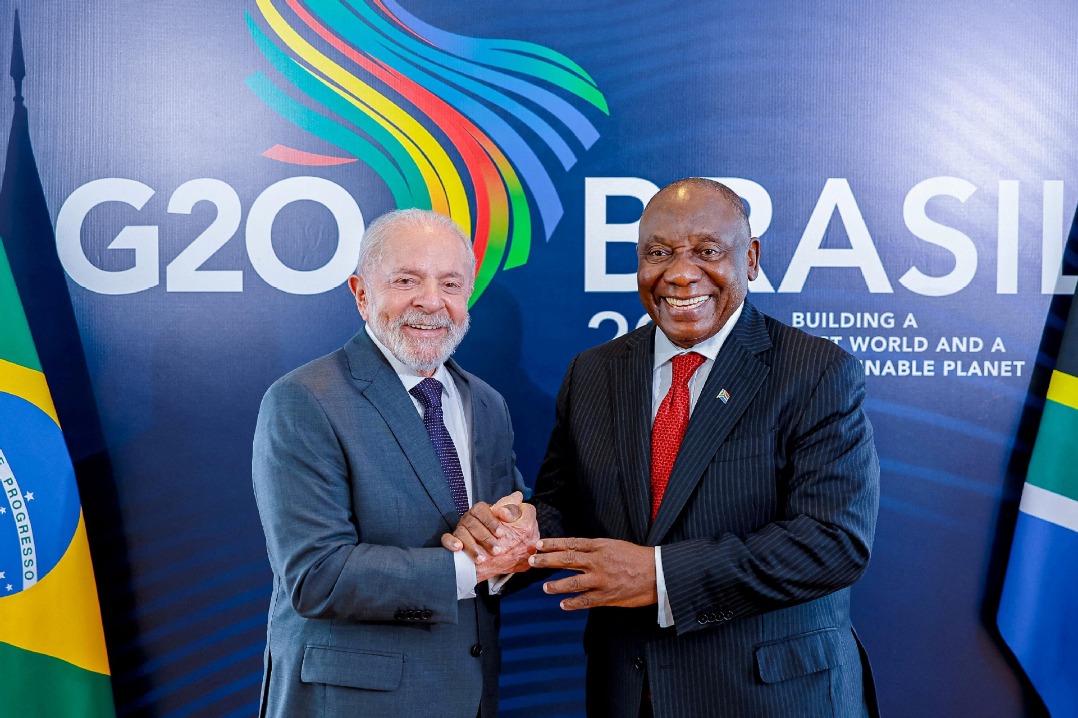Championing global cooperation to crack global challenges
china.org.cn | Updated: 2023-11-17 10:46
Agronomist Thomas A. Lumpkin, one of the first American exchange students in the People's Republic of China since the two countries established diplomatic ties in 1979, and also a recipient of the Chinese Government's Friendship Award, calls for greater cooperation to cope with mounting global challenges.

While some countries ratchet up containment rhetoric against China, in the civil society, the call for more bilateral cooperation to deal with common global challenges, most notably the impacts of climate change, is mounting.
This year, extreme weather set new records with unprecedented heat waves reported worldwide while torrential floods assailed north China and California in the US Climate change and global warming are not just a prediction anymore but a stinging reality.
For American agronomist Dr. Thomas A. Lumpkin, who was director general (2008-2016) of the International Maize and Wheat Improvement Center (CIMMYT) which is headquartered in Mexico, climate change has become very personal. He fainted due to the unbearable heat at his farm in Washington State two years ago.
"It was 50 degrees Celsius on June 28, 2021 on my farm. I've lived most of my life in Washington State and never experienced a temperature this high," Lumpkin told China Today. He likens the effect of global warming to the metaphor of frogs in a pot of water. If they are placed in boiling water, they immediately will jump out, but if they are immersed in tepid water and the temperature is gradually increased to a boil, the frogs will be cooked before they notice what is happening. "We are the frogs, and we keep turning up the heat on our planet. We may not realize the gravity of the situation until it's too late," Lumpkin said.
The World Meteorological Organization confirmed July 2023 as the hottest month on record. "All this is entirely consistent with predictions and repeated warnings. The only surprise is the speed of the change. Climate change is here, it is terrifying … the era of global boiling has arrived," UN Secretary-General António Guterres said on July 27, urging politicians to take swift action.
As a fallout, global food security becomes one of the top concerns for the world. Lumpkin, having been dedicated to increasing global food production and addressing malnutrition through agricultural innovations, says agricultural scientists can indeed develop heat, drought, or insect-resistant crop varieties but in the long run, an integrated and systematic global plan is required to dramatically slash greenhouse gases emissions and address climate change, otherwise, the worst-case scenario will come true. Therefore, global coordination and cooperation is a must, in which he believes China and the US should play a leading role by working together.
A 'warm' bond with China
More than 40 years ago, Lumpkin studied at the Zhejiang Academy of Agricultural Sciences in Hangzhou, east China's Zhejiang province. Those warm moments with his Chinese colleagues are still fresh in his mind. "My colleagues, the Chinese scientists, were just wonderful… friendly and helpful. I made some of the best friends of my life at that time," he told China Today. "Senior professors at that time took me under their wing and guided me. I have very warm feelings."
Lumpkin was an agronomy graduate student in the University of Hawaii when he first came to China in 1976 because of his strong interest in China's traditional fertilizer "green manure" practices – where nitrogen fixing plants are grown and ploughed into the soil to improve its fertility. He bought and reviewed books on traditional Chinese farming practices. After China and the United States resumed their diplomatic ties on January 1, 1979, Lumpkin applied for a US National Science Foundation exchange opportunity and came to China in August that year to research the plant azolla, called Manjianghong in Chinese, a small fern used as a green manure. The research lasted about two years.
During his stay in Zhejiang, Lumpkin lived in the Hangzhou Hotel and his toddler son won everyone's heart. "He was really loved by all the people in the hotel. When we went to eat in the hotel restaurant, the cooks would come out and take my son to the kitchen. When he came out, he would be so happy, holding a baozi (stuffed bun) in each hand," Lumpkin said. "I totally trusted the cooks. Even though it's kind of dangerous in the kitchen, I totally trusted them to take good care of my son."
Lumpkin's interest in China's traditional farming techniques can be traced back to his experience as a volunteer in an Indian village in the 1970s. The villagers were regarded as untouchables due to the rigid caste system prevalent at that time. The lowest stratum of society, they were appallingly poor and couldn't afford fertilizers, resulting in very low crop outputs. When Lumpkin searched for a way to help them, he read about the traditional Chinese methods of using green manures. He began to teach them how to grow rice by using fertilizers and green manure and the yield became five times more abundant.
Azolla grows horizontally in the paddy fields while rice grows vertically. Therefore, they're not competing and the farmer gets free nitrogen nutrient in the soil released by the fern. This traditional Chinese farming practice fascinated Lumpkin, prompting an application for a more systematic study of green manure in China. "Excessive chemical fertilizer can be harmful to the soil. It turns the soil inorganic, into minerals ground up like concrete" while green manure nurtures the soil with "millions of organisms and microbes that are beneficial to the plants."
Lumpkin thinks the use of chemical fertilizers has contributed to climate change as carbon and the organic material in the soil is turned into carbon dioxide emissions. He suggests applying some traditional farming techniques like using green manure. "It's a way we could sequester carbon. We could bring carbon out of the atmosphere, back to the soil where it would help the plants."
Lumpkin collected all the scientific literature in China about the azolla that he could, and later, funded by a research program, went around the world to collect all seven species of the plant since China had only one species. He also wrote a book, Azolla as a Green Manure: Use and Management in Crop Production.
Global cooperation for food security
Speaking of global food security, the work by the late Dr. Norman Borlaug, a world-famous American agronomist, and also an old acquaintance of Lumpkin, deserves special mention. Under a pilot program in Mexico supported by the Rockefeller Foundation and the Mexican Government, Borlaug developed higher-yield wheat varieties that were more resistant to diseases and lodging, and provided higher yields in developing countries in changing conditions. The pilot later evolved into CIMMYT, which now has cooperation projects with countries across the globe. In the 1950s, Borlaug's wheat varieties helped Mexico attain wheat self-sufficiency, and later helped India and Pakistan stave off famine. The widespread adoption of improved varieties and farming practices in the developing world came to be known as the "Green Revolution."
According to media reports, Borlaug's work to increase global food production helped save almost 1 billion people worldwide from starvation, thus earning him the title "Father of the Green Revolution." He also received the Nobel Peace Prize in 1970 for "a lifetime of work to feed a hungry world."
When developing new dwarf wheat varieties for low latitudes, Borlaug studied their genetics at Washington State University, where Lumpkin later became a professor after obtaining his PhD from the University of Hawaii. "Dr. Borlaug cooperated with the wheat breeders at Washington State University who were using Japanese semi-dwarf wheats in their breeding programs, and brought these dwarf wheats, which had been developed for high latitudes, to Mexico. He bred new high yielding varieties that were 'latitude neutral' so that people could grow them at any latitude where wheat is grown," Lumpkin said.
The semi-dwarf trait was also a great improvement for wheat production, as when the wheat plant grows very tall with a big spike of seeds, it may fall down easily, called lodging and rot. Borlaug made high-yield production of dwarf wheat possible even in lower latitudes, in places near the equator. Lumpkin reminisced about his work: In the 1980s and 1990s, "every year he would visit my university. Sometimes we would talk for the whole day. I had experienced the wheat production areas of both India and China, and so we would talk about these countries and what wheat they needed." This was also one of the reasons for Lumpkin's interest to become the director-general of CIMMYT.
"Those Green Revolution wheat varieties were also given to China and used directly or crossed with Chinese varieties to really increase production here," Lumpkin said. Since CIMMYT established its research partnership with China in 1974, around 30,000 varieties of wheat from the international organization's genebank have been introduced to China for breeding programs; more than 500 Chinese students and scholars have received training at CIMMYT's headquarters in Mexico. Since CIMMYT's China office was established in 1997, the cooperation with China has been further boosted in areas such as varietal breeding, genomics research, sustainable farming systems and training. "China has developed 300 new varieties of wheat and maize and released them to farmers, by using the CIMMYT varieties. And it's free," Lumpkin added.
In addition, while receiving training at the CIMMYT headquarters and learning new sciences, Chinese scientists also made friends with scientists from all over the world, which has then greatly promoted China's international cooperation in agriculture. "The training was mainly between the 1970s and 2000. Now, China is giving more than it's receiving. China gives money to CIMMYT to help its budget and technology to help other countries through cooperation programs," Lumpkin told China Today.
Sometimes, CIMMYT also sends scientists from all over the world to China for training. Because of China's remarkable advancement in agricultural sciences, Chinese scientists have become crucial to CIMMYT's efforts to address new crop diseases and other challenges in the developing world.
For his outstanding contribution to promoting Chinese crops and farming methods worldwide and China's international cooperation in agriculture, Lumpkin received the Chinese Government's Friendship Award in 2014. "I felt very honored to receive it. … It was very important for me because there was so much benefit for humanity from introducing Chinese scientists, Chinese technology and Chinese seeds to the world," Lumpkin told China Today.
A new pressing challenge
While the world has equipped itself with the capacity to feed its exploding population by working together, another challenge is looming large, threatening destruction on an unimaginable scale. Climate change is happening with frequent heat waves, droughts and extreme weather events, giving a foretaste of a worsening scenario.
Sea level rise is also accelerating. If the world continues on the pathway of high greenhouse gas emissions and rapid ice sheet collapse, the US National Oceanic and Atmospheric Administration projects that average sea level rise for the US could be 2.2 meters by 2100. Other places in the world would fare no better.
"It's a threat to civilization. Eventually, our governments, our countries could collapse, because so many different kinds of plants, animals are going to die, disappear and crops will fail," Lumpkin said.
Climate change would, of course, impinge on crop yields. If the global warming is not brought under control, by 2099 many countries would face a 40-percent reduction in maize production, including China, Lumpkin predicts. "The maize cannot move north because of the cold nighttime temperature. Maize is very sensitive to nighttime temperature. It'll be too cold at night, and too hot during the day."
But wheat can tolerate cold nights, so it can move north. However, with the high carbon dioxide concentration in the atmosphere, it will have less protein, less zinc and less iron. Therefore, wheat's nutritional quality will be diminished.
While agronomists can ensure some food security by developing heat and drought-tolerant varieties, "it's only going to buy us 10 years, 20 years, and then it will be much worse. And plants won't be able to adjust. We won't be able to develop adapted crop plants," Lumpkin said. "Agriculture scientists cannot change agriculture fast enough to keep up with climate change. We can achieve a few small successes, but the big story is a failure."
However, if China and the United States can work together, Lumpkin thinks the worst-case scenario could be avoided. He regards China as a global leader in many fields of green development: "China leads the world in solar power and wind power. And we need to do better as many other countries are not doing enough, including the United States."
On the other hand, the current tension in the China-US relationship is worrisome. Lumpkin thinks "China needs to be more mature, and it needs to encourage the United States to also be more mature and responsible." He lauds China's efforts in promoting global South cooperation to address climate change, and also speaks highly of what China has achieved over the past 40-plus years.
He partly credits it to China's ancient civilization and long-cherished governance philosophy. Ruling the country with virtue and being people-oriented have been valued throughout Chinese history. He is also amazed by China's collective culture. "You have big groups of people cooperating, working together" to make development plans a reality.
Now, with his interest mainly focused on climate change, Lumpkin speaks on the subject around the world, while being a consultant for international agricultural programs. As he says, if we do nothing today, we'll condemn our future generations to terrifying consequences. He is also trying to bring China and the United States together to deal with climate change and crop genetic resource studies, which he says will be of great significance for the whole world.
As an agronomist who has dedicated his entire career to helping "make sure the world has enough nutritious food to feed everyone" by pushing for international cooperation, Lumpkin thinks now the whole world must work together to address the climate change challenge. It has survived the population boom by breeding new high-yielding crop varieties and improving farming practices through international cooperation; it can do the same with climate change.
























